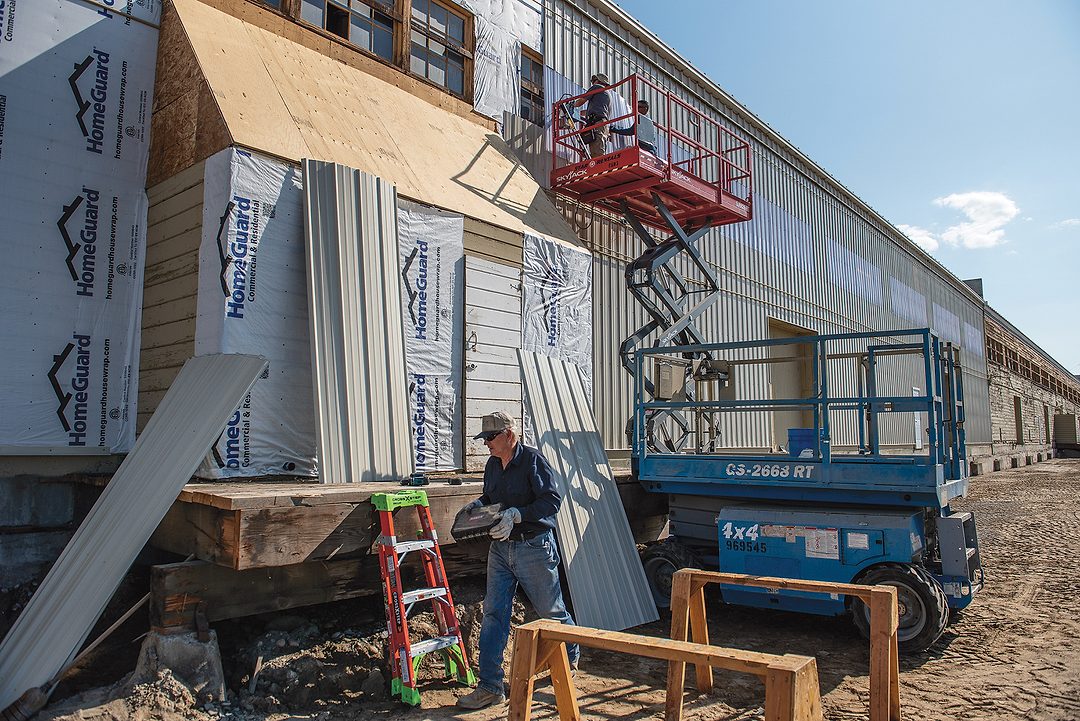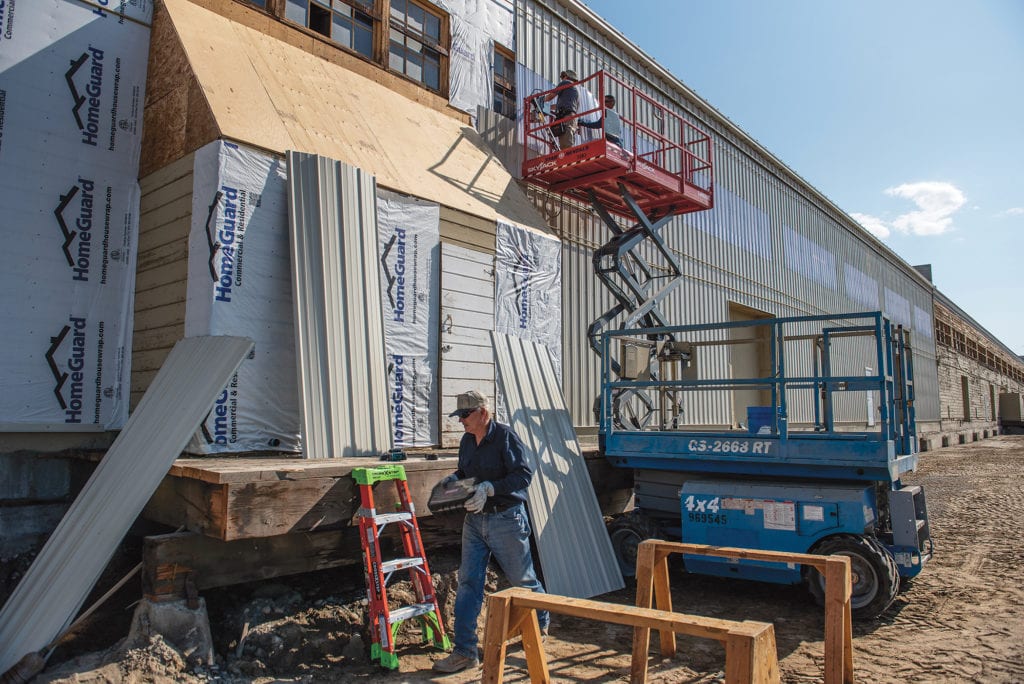
Home » Port of Pasco: Warehouses, airport, wharf developments – oh my!
Port of Pasco: Warehouses, airport, wharf developments – oh my!

October 15, 2019
By Andrew Kirk
The Port of Pasco’s key properties continue to see interest, growth and improvements.
The port manages the Tri-Cities Airport and the marine terminal east of the cable bridge, and promotes the development of land on multiple sites in east Pasco to boost the economy in south Franklin County.
The port’s operations and administration budget annually exceeds $10 million.
“We’ve got barges, we’ve got rail, we’ve got land, we’ve got buildings,” said Mayra Reyna, director of properties for the port. “It’s here.”
The port’s most noticeable construction and real estate activity in 2019 happened at the Big Pasco Industrial Park.
Big Pasco’s eight warehouses on 370 acres at the south end of Highway 397 were originally served by rail lines for an Army depot in World War II and turned over to the port in 1958. Each warehouse has four bays, and each bay is roughly an acre. Since concrete truck bays are now more valuable than railroad docks and bay coverings more practical than wooden canopies, the port is in the middle of a long-term project to replace the docks and canopies and modernize the warehouses.
“One major piece of that is roads,” said Gary Ballew, director of economic development and marketing for the port. “When it rains, the roads sit in standing water and then trucks drive over it… it tends to break the roads down very quickly.”
A new warehouse industrial park would have stormwater drains, but none ever were installed for Big Pasco—in fact, many of the roads were intended to be temporary, he said.
The U.S. Economic Development Administration gave the port a $7.9 million grant in 2019 to add stormwater drain improvements and repave the roads, Ballew said. The port matched with $1.8 million to improve three miles of roads, which could take up to 24 months.
The multi-year modernization project for the warehouses continues. After the wooden docks and canopies are removed, new siding is applied to the building—siding that is purchased from one of Big Pasco’s tenants—Miramac Metals, an arrangement made before the company moved to Big Pasco. The 75-year-old wood is given to tenant Ironsides Custom Grinding for recycling.
The project is moving slowly because it must be done in stages so as not to disturb existing tenants and due to unexpected logistical challenges. When the dock is ripped up, so are the aging wooden stairs. Aluminum stairs are the most practical and cost-effective replacement. When the port orders them, it must seek bids for hundreds of sets of aluminum stairs.
“We’re doing things on a scale we haven’t been able to pursue before,” Ballew said.
It’s all possible because of improving occupancy at Big Pasco.
Reyna said Big Pasco was about half filled when she joined the port three years ago. In 2018, it reached 70 percent occupancy, and in 2019 it’s at 80 percent capacity, she said.
The secret to the port’s success filling the warehouses has been flexible management, he said.
Short-term leases are available. If companies need 10,000 square feet, the port can place them in an empty warehouse and offer the possibility of growing into the remaining 30,000 square feet at a future date. This allows Big Pasco to accommodate businesses of all sizes, he said.
And it’s also a safe gamble, Reyna said. The majority of Big Pasco’s growth has come from existing tenants expanding.

The port’s Foster Wells Business Park in north Pasco has welcomed three new tenants, which leaves three parcels left to fill. Global Trac has signed a lease, and two more were being negotiated in fall 2019, Ballew said.
This success has prompted the port to try to buy another 300 acres in north Pasco near Foster Wells and the Pasco Processing Center, a development featuring larger industrial lots that sold out in 2015—it’s now home to Pasco Processing LLC, Americold, Twin City Foods and Reser’s Fine Foods.
Ballew said the port wishes to offer more large parcels. It was expedient to split some land into smaller parcels to create the Foster Wells Business Center. But with that project nearly complete, a new tract with 300 acres would allow the port to fulfill its original vision for bringing additional food processors to the King Avenue neighborhood. The land is north of the city limits between Highway 395 and North Railroad Avenue.
“Our mission is not to be commercial real estate developers. Our mission is to develop the economy, and often the tool we use to do that is real estate development,” Ballew said. “We buy land, we develop it, and we sell it to other people to put industry on it.”
The port then will add infrastructure, such as water and sewer service, which will be expensive.
Reyna remarked on the irony that much of the port’s best work is not observed by the public because it literally goes on underground. But these commercial land development projects, even with as much of the port’s budget as they take up, are exactly what the region needs for economic development, Ballew said.
The Tri-Cities Airport completed its 10-year master plan in 2018 and is working on its priorities for the coming decade, said airport Deputy Director Don Faley.
A big win for the port was keeping the atmospheric research plane managed by Battelle. The sophisticated aircraft was getting too old to maintain, so Battelle bought a new one that required a larger hangar than the World War II remnant it had been using. Battelle chose to stay in Pasco and build a new 9,000-square-foot facility large enough for the plane, other vehicles used for the atmospheric research and 2,500 square feet of office space for the nine people employed there.
Battelle's old hangar is now available for rent.
Private investment continues to trickle in. In 2018, another new hangar with three spaces was finished, and in 2019 two private box hangars were built on the east side of the airport by private owners.
Out on the tarmac, a $10 million project got underway in 2019 to rehabilitate and realign Taxiway A and make it parallel to the other east-west runway to save pilots time taxiing. The project will be completed in summer 2020 and is 90 percent funded by the Federal Aviation Administration. After realignment, some of the old runway will be pulled up to eventually install a north-south taxiway. Former Taxiway A in the southeast corner of the airfield may become additional apron space for the general aviation sector when there’s a need for it.
Travelers will be able to stay at a new $10 million Courtyard by Marriott at Argent Road and 20th Avenue, just outside the airport entrance, once it opens in late 2019.
It will be a significant resource for business travelers, Faley said.
In 2018, Musser Bros. Inc. opened Trucks and Auto Auctions and built a new hangar west of the airport.
But development in this area has been slow compared to other port land—and especially compared to other areas of north Pasco—because land cannot be sold without FAA approval. That means business owners have to be willing to build their own facilities on leased land, Faley said, a less popular option.
Still, with quick access to the highway, airport, railyards, large neighborhoods and Columbia Basin College, the area still is convenient for many types of businesses, he said.
“At hospitals and airports, you always see construction,” Faley joked.
The port also manages waterfront property east of the cable bridge known as the marine terminal. The vision is a mixed-use development, Ballew said. With its location along the Sacagawea Heritage Trail and only a few blocks from downtown Pasco, several options are possible. One hang-up for future development is some of the most intriguing proposals want to use the wharf, and a recent assessment determined it needs repairs.
“The wharf is really this iconic feature,” Ballew said. “The wharf would be an important part of the marine terminal site.”
Divers tested the footings and came back with positive reports on the wharf’s stability—except for the pier caps, which transfer weight from the platform down through the pier to the footings. Ballew said the challenge is knowing what kind of renovation to perform, which would be determined by how the wharf will be used. Port commissioners will be considering how best to proceed in 2020.
The Tri-Cities Public Market Foundation is one group that expressed an interest in bringing an indoor public market to the wharf.
“Our board fell in love with the marine terminal the second we stood on that wharf. Someone is going to do something very special with that site one day,” said Adam (Brault) Avenir, president of the foundation.
Ballew said the marine terminal also could host some of the river cruise ships that currently dock at Howard Amon Park. Tourists could disembark to visit Lewis and Clark Trail landmarks or area wineries. Or perhaps it could be a place where small leisure boats dock so people could enjoy a drink or a meal after being out on the water. All three ideas would require a different renovation, Ballew said.
The goal now is to present the port’s commission with all the information it needs to begin a decision-making process early in 2020, he said.
Construction + Real Estate
KEYWORDS october 2019





